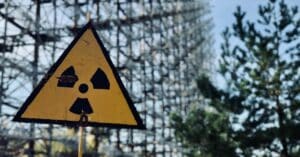A fire starting can have disastrous consequences for your business. But assessing the risks and controlling hazards as much as possible can help you to minimise the chances of a fire starting or spreading.
Protect your team and your business by taking steps to put fire safety at the forefront, reduce fire risks in your workplace, and maintain high health and safety standards for your business.
Key Points:
- Fire hazards are a serious topic which shouldn’t be taken lightly, and all dangers should be looked at to keep everyone in your team safe
- If you’re not found to be complying with fire safety regulations, you could find yourself in court, paying fines of up to £20,000.
- Regular risk assessments will help you to keep on top of fire hazards and reduce the chances of fire breaking out.
What are fire hazards?
According to the Health and Safety Executive, there are three components needed to start a fire.
- Ignition such as a naked flame or a heater
- Fuel, e.g., wood, paper, or waste rubbish
- Oxygen
When these three things come together, there is a high risk of fire.
In specific workplaces such as manufacturing, there may also be flammable materials to look out for, such as particular chemicals, that pose a risk of fire and injury to workers within the vicinity.
Any of these things can be classed as hazards and should be handled as such to reduce the chances of fire breaking out.
What are the risks/dangers?
If a fire breaks out and isn’t contained, it can pose a risk of injury, and even death, to your team. It’s a serious topic which shouldn’t be taken lightly, and all dangers should be looked at to keep everyone in your team safe.
There is also the potential for damage to your workplace, materials, and stock, if a fire were to break out, which could be devastating, especially for small companies.
A NEBOSH Certificate in Fire Safety offers training for construction workers, and could help you manage the risk of fire breaking out. Your team could learn more about fire risks, safety in the workplace, and fire prevention systems.
What are the legal requirements for businesses?
As the person in charge of fire safety, you’ll need to make sure you’re fulfilling all your legal responsibilities.
You’ll need to do a fire risk assessment to identify hazards in your workplace, such as potential ignition and fuel, and who is working closely with them. Once you have your assessment completed, you can determine the actions you need to take to protect your workers and keep the business running smoothly.
You’ll need to work out:
- Where to store ignition and fuel, to keep them apart
- How people can evacuate easily, in case fire breaks out, e.g. the fire exit routes they can use
- What measures you’ll take to control a fire
- How you’ll alert the team to a fire
- What fire safety training you’ll provide to the workforce
- How you’ll provide extra support for any vulnerable people you have on the team
If you’re not found to be complying with fire safety regulations, you could find yourself in court, paying fines of up to £20,000. It’s important to have a fire strategy in place for the wellbeing of your team, and the future of your business.
Putting fire extinguishers around the site, training a fire warden, and installing fire doors, are all legal requirements for any business.
Any electrical equipment you’re using needs to be tested before it comes onsite to reduce the risk of a fire occurring, and fire safety procedures should be shared with all employees so everyone is fully aware of what they need to do, should a fire break out. Carrying out regular fire drills can help to reinforce this with the whole team.
Smoke alarms are not currently a legal requirement, but there should be some form of ‘appropriate fire detection system’ in place, according to current legislation. That could be in the form of smoke alarms, or another method that will quickly and effectively alert employees that they need to evacuate immediately.
What injuries can occur?
There were 97 fire-related injuries in industrial premises between 2020/21, so it’s vital that you do as much as you can to protect your team.
Burns are the obvious injury when it comes to a fire; they can affect your muscles, nerves, and bones, causing permanent damage in more extreme cases.
However, smoke inhalation can also be highly dangerous, causing complications with the respiratory system.
What are the main causes of fire?
Of the 11,916 fires that took place in England between 2020/21, over 14% occurred in industrial premises, which highlights the need for extra care within sectors such as manufacturing.
Within the same time period, the top causes of fires for non-residential buildings were:
- Faulty appliances and leads (1,707)
- Faulty fuel supplies (1,321)
- Misuse of equipment or appliances (925)
- Careless handling of fire or hot substances (877)
Workplace fires are easily preventable with extra care taken to check appliances, fuel supplies, and equipment before use. A fire safety training course would also be beneficial to help workers understand the correct way to use equipment, and handle combustible materials if they’re working closely with them.
How can companies manage and prevent accidents and injuries from occurring?
Regular risk assessments will help you to keep on top of fire hazards and reduce the chances of fire breaking out. If there are ways to eliminate the risk completely, this should certainly be your first port of call.
Keeping a close eye on the substances used in your production line or other business processes can help you to determine the risk associated with potentially flammable materials too. If it’s at all possible, try to store flammable materials off-site to reduce the risk of combustion.
It’s important to review your waste processes too and ensure there’s no possibility of a fire starting among built-up rubbish such as large quantities of paper.
Fire Safety training
Training your team in fire safety is a great way of keeping risks down, and improving knowledge across the business.
Whether you take an in-person course, or join a virtual session, the 28 hours you’ll spend building your fire safety awareness will help you to protect your employees, and your business.
Take a look at our NEBOSH Certificate in Fire Safety and see what we can do for your team to improve safety in your workplace.






